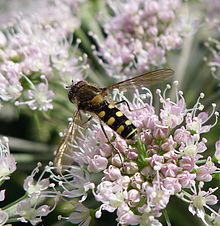Melangyna compositarum
| Melangyna compositarum | |
|---|---|

| |
| Melangyna compositarum | |
| Scientific classification | |
| Domain: | Eukaryota |
| Kingdom: | Animalia |
| Phylum: | Arthropoda |
| Class: | Insecta |
| Order: | Diptera |
| Family: | Syrphidae |
| Genus: | Melangyna |
| Species: | M. compositarum
|
| Binomial name | |
| Melangyna compositarum (Verrall, 1873)
| |
| Synonyms | |
|
| |
Melangyna compositarum is a Holarctic species of hoverfly.[1][2]
Description[edit]
External images Wing length: 5.25–8.5 mm (0.207–0.335 in).The face is narrower and shinier than in Melangyna labiatarum . In males, the sides of the face are almost parallel and the eyes are very slightly hairy. The thorax is shinier than in M. labiatarum male. See references for determination.[3] [4] [5][6] The male terminalia are figured by Hippa (1968) ).[7] The larva is undescribed.
Distribution[edit]
Palearctic Fennoscandia South to the Pyrenees and northern Spain. Ireland eastwards through North Europe and Central Europe northern Italy and Yugoslavia. Then East into European Russia and Siberia from the Urals to the Pacific coast (Kuril Islands) Nearctic Alaska South through the Rocky mountains to New Mexico.[8][9][10]
Biology[edit]
Habitat: Larix, Pinus forests.[11] Arboreal, but descends to visit flowers of white Umbelliferae, Galium, Sorbus aucuparia.[12] The flight period is end May to September (July to September at higher altitudes). The larva feeds on aphids.
References[edit]
- ^ Stubbs, Alan E.; Falk, Steven J. (1983). British Hoverflies: An Illustrated Identification Guide (2nd ed.). London: British Entomological and Natural History Society. pp. 253, xvpp. ISBN 1-899935-03-7.
- ^ Ball, S.G.; Morris, R.K.A. (2000). Provisional atlas of British hoverflies (Diptera, Syrphidae). Monks Wood, UK: Biological Record Centre. pp. 167 pages. ISBN 1-870393-54-6.
- ^ Van Veen, M. (2004). Hoverflies of Northwest Europe: Identification keys to the Syrphidae. 256pp. KNNV Publishing, Utrecht.addendum
- ^ Van der Goot,V.S. (1981) De zweefvliegen van Noordwest - Europa en Europees Rusland, in het bijzonder van de Benelux. KNNV, Uitgave no. 32: 275pp. Amsterdam.
- ^ Bei-Bienko, G.Y. & Steyskal, G.C. (1988). Keys to the Insects of the European Part of the USSR, Volume V: Diptera and Siphonaptera, Part I. Amerind Publishing Co., New Delhi. ISBN 81-205-0080-6.
- ^ Coe, R.L. (1953). "Diptera: Syrphidae". Handbks.ident.Br.insects 10(1): 1-98. R. ent. Soc. London. pdf
- ^ Hippa, H. (1968) A generic revision of the genus Syrphus and allied genera (Diptera: Syrphidae) in the Palearctic region, with descriptions of the male genitalia. Acta Ent.Fenn., 25: 1-94.
- ^ Fauna Europaea
- ^ Peck, L.V. (1988) Syrphidae. In: Soos, A. & Papp, L. (eds.) Catalogue of Palaearctic Diptera, 8: 11-230. Akad.Kiado, Budapest.
- ^ Vockeroth, J.R. (1992). The Flower Flies of the Subfamily Syrphinae of Canada, Alaska, and Greenland (Diptera: Syrphidae). Part 18. The Insects and Arachnids of Canada. Ottawa, Ontario: Canadian Government Pub Centre. pp. 1–456. ISBN 0-660-13830-1.
- ^ Speight, M.C.D. (2011). "Species accounts of European Syrphidae (Diptera)" (PDF). Syrph the Net, the database of European Syrphidae. 65: 285pp.
- ^ de Buck, N. (1990). "Bloembezoek en bestuivingsecologie van Zweefvliegen (Diptera, Syrphidae) in het bijzonder voor België". Doc.Trav. IRSNB, no. 60, pp. 1-167.
